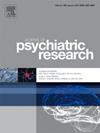Adverse childhood experiences and left hippocampal volumetric reductions: A structural magnetic resonance imaging study
IF 3.7
2区 医学
Q1 PSYCHIATRY
引用次数: 0
Abstract
Background
Adverse childhood experiences (ACEs) have been associated with volume alterations of stress-related brain structures among aging and clinical populations, however, existing studies have predominantly assessed only one type of ACE, with small sample sizes, and it is less clear if these associations exist among a general population of young adults.
Objective
The aims were to describe structural hippocampal volumetric differences by ACEs exposure and investigate the association between ACEs exposure and left and right hippocampal volume in a student sample of young adults.
Methods
959 young adult students (18–24 years old) completed an online questionnaire on ACEs, mental health conditions, and sociodemographic characteristics. Magnetic resonance imaging (MRI) was used to measure left and right hippocampal volume (mm3). We used linear regression to explore the differences of hippocampal volumes in university students with and without ACEs.
Results
Two thirds of students (65.9%) reported ACEs exposure. As ACEs exposure increased there were significant volumetric reductions in left (p < 0.0001) and right hippocampal volume (p = 0.001) and left (p = 0.0023) and right (p = 0.0013) amygdala volume. After adjusting for intracranial brain volume, sex, age, and depression diagnosis there was a negative association between ACEs exposure and left (β = −22.6, CI = −44.5, −0.7, p = 0.0412) but not right hippocampal volume (β = −18.3, CI = −39.2, 2.6, p = 0.0792). After adjusting for intracranial volume there were no associations between ACEs exposure and left (β = −9.2, CI = −26.2, 7.9 p = 0.2926) or right (β = −5.6, CI = −19.9,8.8 p = 0.4466) amygdala volume.
Conclusions
Hippocampal volume varied by ACEs exposure in young adult students. ACEs appear to contribute to neuroanatomic differences in young adults from the general population.
童年的不良经历与左侧海马体积缩小:结构性磁共振成像研究。
背景:童年不良经历(ACEs)与老龄化和临床人群中与压力相关的大脑结构的体积变化有关,然而,现有研究主要只评估了一种类型的ACE,样本量较小,而且不太清楚这些关联是否存在于一般的青壮年人群中:方法:959 名青年学生(18-24 岁)填写了一份关于 ACE、心理健康状况和社会人口特征的在线问卷。磁共振成像(MRI)用于测量左右海马体积(mm3)。我们使用线性回归法探讨了有无ACE的大学生海马体积的差异:结果:三分之二的学生(65.9%)报告了ACEs暴露。随着暴露于 ACEs 的增加,左侧海马体积显著减少(p 结论:海马体积因暴露于 ACEs 而异:青年学生海马体积因接触 ACEs 而异。ACE似乎是造成青壮年与普通人群神经解剖结构差异的原因之一。
本文章由计算机程序翻译,如有差异,请以英文原文为准。
求助全文
约1分钟内获得全文
求助全文
来源期刊

Journal of psychiatric research
医学-精神病学
CiteScore
7.30
自引率
2.10%
发文量
622
审稿时长
130 days
期刊介绍:
Founded in 1961 to report on the latest work in psychiatry and cognate disciplines, the Journal of Psychiatric Research is dedicated to innovative and timely studies of four important areas of research:
(1) clinical studies of all disciplines relating to psychiatric illness, as well as normal human behaviour, including biochemical, physiological, genetic, environmental, social, psychological and epidemiological factors;
(2) basic studies pertaining to psychiatry in such fields as neuropsychopharmacology, neuroendocrinology, electrophysiology, genetics, experimental psychology and epidemiology;
(3) the growing application of clinical laboratory techniques in psychiatry, including imagery and spectroscopy of the brain, molecular biology and computer sciences;
 求助内容:
求助内容: 应助结果提醒方式:
应助结果提醒方式:


